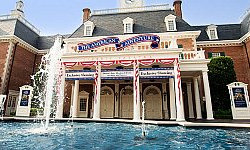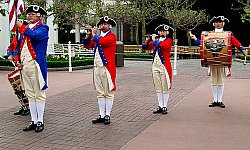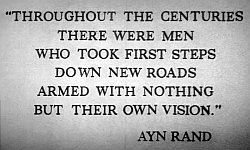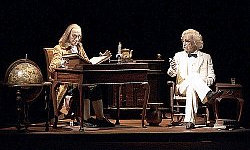FROM: The 626 Published Fridays
The American Adventure
The American Adventure is the 'crown jewel' of Epcot's World Showcase. Jeff Heimbuch interviewed on Wednesday one of its creators, Imagineer Steve Alcorn, and now Jeff returns with an in-depth look at the pavilion's architecture and animatronics.
On Wednesday, I interviewed Steve Alcorn, one of the Imagineers who created The American Adventure, and so I think now is a good time to take a closer look at the pavilion, regardled by many as the centerpiece of Epcot's World Showcase.
America on Stilts
Originally, Disney didn't plan to include the United States as one of the pavilions encircling the lagoon. Instead, they wanted to 'house' the pavilion in a two-story building elevated on stilts between Future World and the World Showcase.
The first level would be a tunnel, or gateway, between Future World and the Showcase, and the second level would be the pavilion itself.
After someone shot down that idea, Disney moved the American Adventure into the central position of the World Showcase so that guests would be able to see it as they walked around the lagoon. This central positioning was meant to represent the fact that the United States was playing 'host' to the other pavilions.
Architecture of The American Adventure
The American Adventure building is notable for a few reasons.
The first is forced perspective, a technique used elsewhere at Disney World, especially on Main Street, U.S.A., where it makes the buildings appear larger than their actual size.
The American Adventure building uses REVERSE forced perspective. The building had to be large enough to house a massive theatre show, but not so large that it would appear inappropriate for its time period. So, the Imagineers built it to look smaller than its actual size. Disney also built the American Adventure on an elevation slightly higher than that of the adjacent pavilions, giving the Imagineers more room for the show.
Architectually, the building is an amalgam of elements borrowed from Independence Hall, Monticello, Boston's Old State House, and Colonial Williamsburg. Disney used 110,000 hand-made, Georgian clay bricks, colored and aged for authenticity, and they gave the building a slate roof with a widow's walk, bell tower, and clock.
click an image to expand:

The American Adventure

A Fife and Drum Corps Performing Outside

One of the Many Framed Quotes in the Rotunda

Mark Twain and Benjamin Franklin from the American Adventure Show
Look closely at that clock and you'll see the Roman numerals on its face. Look more closely and you'll see that the clock uses IIII instead of IV. It's not a mistake. During the colonial period, clock-makers often used IIII. You'll see the same notation on the clock in front of Cinderella Castle.
Outside the building, you'll find the American Gardens Theater, where various shows (usually) are held daily, including the Candlelight Processional during the holiday season. Around back is the Golden Dream, a replica of a Virginia Sloop. These ships were used for trading and feature a flat deck to hold large amounts of supplies. The Golden Dream was restored in 2006.
Inside the building, you'll find a gorgeous rotunda with marble floors and a dome ceiling. If you get there at the right time, you may catch a patriotic performance from the a cappella musical group Voices of Liberty. They usually perform about 15 minutes before each American Adventure show.
The rest of the pavilion is decorated in typical colonial era style, with reproductions of classic paintings hung on the wall alongside framed quotes by some of America's most notable citizens.
As you leave the rotunda and head for the theater, you travel through the Hall of Flags. Look up to see a collection of 44 flags that have flown over the United States during key moments of its history. The flags include those flown during the Revolutionary War and the Colonial Era, and also flags flown by foreign nations who had once staked a claim on our territory.
Audio-Animatronics of the American Adventure
When you get into the theatre, you'll see that each side is flanked by 12 statues, 6 per side, called the Spirits of America. On the right side of the theater, the Spirits are Freedom, Heritage, Pioneering, Knowledge, Self-Reliance, and Adventure, and on the left they are Individualism, Innovation, Tomorrow, Independence, Compassion, and Discovery. The statues are life-sized and they figure into the final sequence of the show
Benjamin Franklin and Mark Twain are your hosts during your journey through America's history. The 30 minute show highlights numerous important events and quite a few notable personalities who left their marks on American history. The show uses a combination of audio-animatronic figures, moving sets, various special lighting effects, and filmed images projected onto the 155 feet wide screen. Disney's attentive eye for detail is evident, as the speeches and broadcasts used in the show are straight from the original text and, where available, the actual recordings.
The show features 35 audio-animatronic figures in scenes that include the Mayflower landing at Plymouth Rock, the Boston Tea Party, the writing of the Declaration of Independence, Valley Forge and the Revolutionary War, World Wars I and II, and much more! The show ends with a film montage that Disney updated in June 2007 to depict more recent events in American history
In addition to showcasing our pride as a nation, the show is notable for a few of its technical feats. It includes a range of motions for some of the audio-animatronics that were quite revolutionary for the time. For example, Benjamin Franklin seems to walk up a set of stairs in one scene, which is still quite a sight today! In reality, the figure is incrementally lifted into place one step at a time. Since he is placed next to the stair's railings, it helps to sell the illusion that he is walking up a flight of stairs.
A computer controlled device nicknamed 'the War Wagon' changes the massive sets between scenes. This movable device is located directly under the theater, measures 65-by-35-by-14 feet, and weighs 175 tons.
The building itself is quite a sight to behold, but far too often, families rush by on their way to the next attraction without so much as a glance inside.
Next time you're in Epcot, take a few minutes to explore the American Adventure Pavilion, and maybe learn a thing or two about America's great heritage!
The American Adventure Fact Sheet
In order of appearance, these figures appear during the show:
- Ben Franklin (3 figures)
- Mark Twain (3 figures)
- Thomas Jefferson
- George Washington
- Washington's horse
- Two soldiers in Valley Forge
- Frederick Douglass
- A Civil War-era family consisting of a father, mother, baby, daughter, and two brothers
- Mr. Brady (a Civil War-era photographer)
- Chief Joseph
- Alexander Graham Bell
- Andrew Carnegie
- Susan B. Anthony
- Theodore Roosevelt
- John Muir
- Four men and a dog in a 1929 gas station scene
- Franklin D. Roosevelt
- Will Rogers
- Rosie the Riveter
- Two battleship crew members (one male and one female)
In order of performance, these songs are played during the show:
- "New World Bound," which is played against the backdrop of a series of paintings depicting the Mayflower voyage and the Pilgrims' landing at Plymouth Rock.
- "In The Days of '76," which is played during various scenes of the Revolutionary War.
- "Two Brothers," telling the Civil War story of two brothers, fighting on opposite sides of the War.
- "Brother, Can You Spare a Dime?", sung by a banjo player in a 1930s gas station.
- "I'll Be Home For Christmas," which is heard in the background of the Rosie the Riveter scene.
- "Golden Dream," sung during the film montage and the show's finale.
And did you know:
- The audio-animatronic figures have wigs made of real human hair!
- The furniture in some of the scenes are antiques from their respective time periods.
- In the 1930s gas station scene, the two signs over the gas station are promoting Coca-Cola and American Express.
- The rear projection screen is 28 feet high and 155 feet long.
- The rear-projection movie required the longest single loop of film ever employed for a Disney show. The film, some 3,330 feet long, snakes up and down through rollers in seven specially designed storage cabinets.
- This show marks the first time audio-animatronic characters were equipped with individual voices and speakers. In the past, narrations had been played over a theater speaker system.
Follow me on Twitter for updates!
More: The 626
Stuff Not to Skip
- The American Adventure
http://disneyworld.disney.go.com/parks/epcot/attractions/american-adventure - The American Adventure on Wikipedia
http://en.wikipedia.org/wiki/The_American_Adventure - Jeff Heimbuch's Bamfer Productions
http://www.bamferproductions.com







